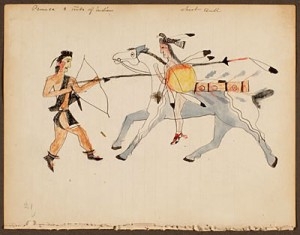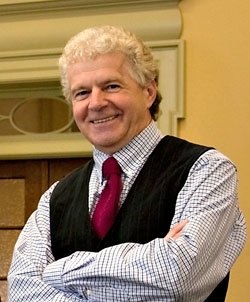
Ledger Art from the Mark Lansburg collection is the focus of much scholarly attention at Dartmouth this fall. (Short Bull, Lakota, about 1845-1915, untitled)
As part of the 2010 Leslie Humanities Institute,“Multiple Narratives in Plains Indian Ledger Art,” Dartmouth College is hosting several gallery talks and lectures on Mark Lansburgh ’49’s extensive collection of Plains Native American ledger art, which Dartmouth’s Hood Museum of Art acquired in 2007.
On Thursday, October 21, Mike Cowdrey will host a gallery talk at 2 p.m. in the Hood. Cowdrey is the author of Arrow’s Elk Society Ledger: A Southern Cheyenne Record of the 1870s and co-author of American Indian Horse Masks. Gallery talks organized by the Hood Museum of Art are open to the public. Cowdrey will also deliver a lecture entitled, “Recognizing the Artists and Identifying the Subjects of Ledger Drawings in the Mark Lansburgh Collection,” on Friday, October 22, in Haldeman, Room 246. Please contact Colin Calloway if you wish to attend this lecture or any of the weekly Friday talks by institute fellows.
Cowdrey’s talk on Friday will be followed by a lecture by Colin Calloway on “The Mission of Eleazar Wheelock, the Vision of Luther Standing Bear, and Why Ledger Art Matters at Dartmouth College.” This lecture will be held in Loew Auditorium at 5:30 p.m. Calloway is a Professor of History and Native American Studies and director of the Ledger Arts Institute; his talk is open to the public. Calloway is the author of The Indian History of an American Institution: Native Americans and Dartmouth.

Colin Calloway, professor of history and Native American studies, is the director of the 2010 Leslie Humanities Institute “Multiple Narratives in Plains Indian Ledger Art.” (photo by Joseph Mehling ’69)
In collaboration with Native American Studies and the Hood, the Leslie Humanities Institute aims to increase appreciation of the artistic merit of this ledger art, which features many important aspects of the cultural and physical struggles the Native Americans in the Plains faced in the second half of the nineteenth century. Furthermore, the series will examine these works within the context of the complexities of Native American re-negotiation of identity and relations with non-Native Americans at this time.
Led by Calloway and featuring Joyce Szabo of the University of New Mexico as William H. Morton Distinguished Fellow, the fall Institute draws together a distinguished selection of fellows and participants from a wide variety of scholarly backgrounds, ranging from law to art history. The fellows meet weekly to discuss their research and hear from visiting scholars. Among the Institute speakers is exhibit curator Joe D. Horse Capture, the associate curator of Native American Art for the Minneapolis Institute of Arts, who will lecture on November 4 at 2 p.m. These presentations will address the drawings economically, regionally, artistically, sociologically, and psychologically in an attempt to expose the works’ multiple narratives.
“The Leslie Institute in Plains Indian ledger art, running concurrently with the Hood Museum’s exhibit, represents a unique opportunity for Dartmouth,” says Calloway. “Scholars of ledger art come to campus to discuss their work and study the sketches, the museum draws on their expertise in building knowledge about the collection, and faculty learn ways to incorporate these remarkable drawings into their classes.”
Visit the Leslie Center’s website for a schedule of events.

The Leslie Center for the Humanities hosts a series of seminars and lectures on Native American ledger art as part of its fall Institute.
